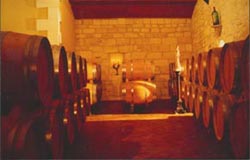
Learn everything about Chateau Mauvezin St. Emilion with wine tasting notes, wine and food pairings, best vintages, a history of the property, information on the vineyards and winemaking. If you want to read about other important, Bordeaux Chateaux: Links to all Bordeaux Wine Producer Profiles
Chateau Mauvezin Vineyards, Terroir, Grapes, Winemaking
This small, obscure 3.5 hectare Bordeaux vineyard of Chateau Mauvezin in St. Emilion is planted to 50% Merlot, 40% Cabernet Franc and 10% Cabernet Sauvignon.
On average, the vines at Chateau Mauvezin are old. In fact, the vines are close to 50 years of age. The average vine density in the vineyard of Chateau Mauvezin is between 5,400 and 6,600 vines per hectare. The younger plantings are at high levels of density. The production of Chateau Mauvezin is close to 1,200 cases per vintage.
Chateau Mauvezin is the property of the Cassat family who purchased the vineyard in 1968. Even though the chateau dates back to the early 1700s, giving them a lot of history in the Bordeaux region.
The estate has the distinction of being one of the more obscure Right Bank wines, especially considering that at one point, the property was previously a St. Emilion, Grand Cru Classe’ Classified wine. The Cassat family also own Domaine de Peyrelongue and Chateau Haut Badon.
Serving and Decanting Chateau Mauvezin, with Wine and Food Pairings
Chateau Mauvezin is best served at 15.5 degrees Celsius, 60 degrees Fahrenheit. The cool, almost cellar temperature gives the wine more freshness and lift.
Young vintages can be decanted for up to 1 hour. This allows the wine to soften and open its perfume. Older vintages might need very little decanting, just enough to remove the sediment. Chateau Mauvezin is best paired with all types of classic meat dishes, veal, pork, beef, lamb, duck, game, roast chicken, roasted, braised, and grilled dishes. Chateau Mauvezin is also good when matched with Asian dishes, rich fish courses like tuna, mushrooms, and pasta.
In total, they have 13 hectares of vines in total in St. Emilion. In 2014, the Cassat family, through their holding company, Vignobles Cassat, sold all three of their estates to the owner of Chateau La Gaffeliere, Alexandre de Malet-Roquefort.
I would not be surprised to see the vines from the estate’s best parcels and terroir eventually merged into those of Chateau La Gaffeliere.
